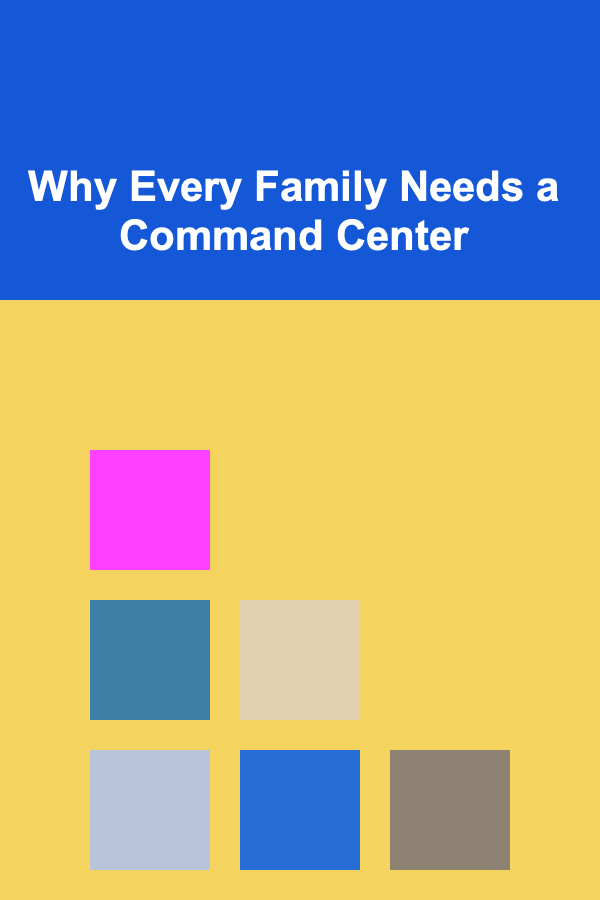
Why Every Family Needs a Command Center
ebook include PDF & Audio bundle (Micro Guide)
$12.99$10.99
Limited Time Offer! Order within the next:

In the fast-paced, often chaotic world we live in today, families face an increasing number of responsibilities and commitments. From juggling work schedules to keeping track of children's activities, maintaining a household requires organization and communication. This is where the concept of a family command center comes into play. A command center serves as a centralized hub for managing daily life, helping families stay organized, connected, and stress-free. In this comprehensive guide, we will explore what a command center is, its benefits, essential components, and tips for setting one up.
Understanding the Family Command Center
1. What Is a Family Command Center?
A family command center is a designated area within the home that consolidates important information, schedules, and resources for family management. It acts as a central hub where all members of the family can access necessary information and tools to facilitate smoother day-to-day operations.
2. Benefits of Having a Command Center
The advantages of establishing a command center in your home are numerous:
- Organization: Keeps everyone on the same page regarding schedules, tasks, and responsibilities.
- Efficiency: Reduces time spent searching for items, documents, or information.
- Communication: Enhances family communication by providing visibility into each other's commitments.
- Stress Reduction: Alleviates the mental load associated with remembering everything by having a centralized location for details.
Essential Components of a Family Command Center
For a command center to be effective, it should include several key components that cater to the needs of your family.
1. Calendar System
a. Wall Calendar
A large wall calendar is crucial for tracking events, appointments, and deadlines:
- Visual Overview: Offers a clear visual layout of the month, making it easy to spot conflicts.
- Color-Coding: Assign different colors for each family member's schedule to simplify understanding.
b. Digital Calendar Integration
While a physical calendar works well, digital integration can offer additional flexibility:
- Shared Calendars: Use apps like Google Calendar to create shared calendars for everyone in the family.
- Notifications and Reminders: Set up alerts for upcoming events directly through your smartphones.
2. To-Do Lists
a. Family Tasks Board
A dedicated space for to-do lists helps keep everyone accountable:
- Magnetic or Dry-Erase Boards: Use boards to jot down daily or weekly tasks that need attention.
- Categorization: Group tasks by family member or type (e.g., chores, errands) for clarity.
b. Digital Task Management
Consider complementing the board with a digital task management tool:
- Apps: Use applications like Todoist or Trello for more complex projects or long-term goals.
- Accessibility: Ensure that everyone has access to these digital tools via their devices.
3. Information Hub
a. Important Documents
Create a space for important contacts and documents:
- Emergency Contacts: List phone numbers for doctors, schools, and emergency services.
- Medical Records: Store essential medical records or insurance information for quick access.
b. School and Activity Information
Keep track of important school-related information:
- Permissions Slips and Schedules: Organize forms and schedules for extracurricular activities.
- Meal Plans: Consider placing meal plans or dietary needs in this section for reference during shopping.
4. Communication Tools
a. Message Board
A message board fosters communication among family members:
- Sticky Notes or Pins: Use sticky notes for quick reminders or messages.
- Weekly Updates: Designate a section for weekly updates or notes from parents to kids.
b. Family Meeting Space
Designate a regular time for family meetings to discuss schedules, issues, and plans:
- Open Discussions: Encourage open dialogue about everyone's commitments and feelings.
- Decisions and Planning: Use this time to make decisions collaboratively.
5. Visual Inspiration
a. Photo Display
A display of family photos adds warmth and personal touch:
- Memories and Achievements: Include pictures of family milestones, achievements, and vacations.
- Motivation: Use motivational quotes or affirmations to inspire positivity.
b. Vision Board
Consider creating a vision board as part of your command center:
- Goals and Dreams: Use this space to visualize family goals, whether they're related to travel, education, or personal development.
- Creativity: Allow family members to contribute ideas and images, fostering collaboration.
Setting Up Your Family Command Center
Establishing a family command center may seem daunting at first, but with a systematic approach, it can become an integral part of your home.
Step 1: Choose the Location
Identify a suitable location for the command center:
- High-Traffic Areas: Opt for areas frequently visited, such as the kitchen or entryway, to ensure visibility.
- Space Consideration: Make sure the chosen space accommodates all necessary components.
Step 2: Gather Supplies
Collect supplies required for setting up the command center:
- Calendars: Purchase or create a monthly wall calendar.
- Boards: Acquire magnetic or dry-erase boards for to-do lists and messages.
- Storage Solutions: Find boxes or folders for organizing papers and documents.
Step 3: Involve the Family
Engage family members in the setup process:
- Collaborative Decision-Making: Discuss what components are most important to everyone.
- Personal Touches: Allow each family member to add personal touches, such as decorations or favorite quotes.
Step 4: Implement Technology
Integrate digital tools to enhance the command center:
- Shared Apps: Download and set up shared calendar and task management apps.
- Synchronization: Ensure everyone syncs their devices to access the same information seamlessly.
Step 5: Review and Adapt
Once established, regularly review the command center's effectiveness:
- Family Feedback: Ask for feedback from family members to assess usability.
- Adaptation: Be open to making changes based on evolving family needs and schedules.
Managing Chaos with a Command Center
Even with a command center in place, life can still get chaotic. Here are strategies to manage unexpected disruptions effectively:
1. Flexibility
Understand that plans may need to change:
- Adjustable Systems: Ensure your scheduling system allows for quick adjustments.
- Open Communication: Maintain ongoing dialogue about changes to minimize confusion.
2. Time Management Strategies
Implement time management techniques to cope with a busy lifestyle:
- Prioritization: Teach family members to prioritize tasks based on urgency and importance.
- Time Blocking: Use time blocking methods to allocate specific periods for focused work or family time.
3. Emergency Preparedness
Prepare for emergencies by having a clear plan in place:
- Emergency Kits: Keep emergency kits in easily accessible locations, clearly labeled.
- Training: Familiarize everyone with emergency protocols and how to access the command center during stressful situations.
The Role of Technology in a Command Center
Technology can significantly enhance the functionality of a family command center. Here are some ways to incorporate technology effectively:
1. Smart Home Integration
Consider integrating smart home devices into your command center:
- Smart Displays: Use smart displays to show calendars, reminders, and even recipes.
- Voice Assistants: Leverage voice assistants to set reminders and answer questions quickly.
2. Mobile Accessibility
Ensure the command center's information is easily accessible on mobile devices:
- Apps and Notifications: Set up mobile apps to send notifications for important events or tasks.
- Sync Across Devices: Regularly sync information across devices to maintain consistency.
3. Online Resources
Utilize online tools and resources to streamline organization:
- Online Calendar Platforms: Utilize platforms like Google Calendar or Outlook for seamless scheduling.
- Document Storage: Consider cloud storage solutions like Google Drive or Dropbox for accessing important documents anytime.
Creating a Sustainable Command Center
Once your command center is set up, sustaining its effectiveness is key:
1. Routine Maintenance
Establish a routine for maintaining the command center:
- Weekly Reviews: Schedule a time each week to review the calendar, to-do lists, and any pending tasks.
- Decluttering: Regularly declutter unnecessary papers or items to keep the space organized.
2. Family Accountability
Encourage accountability among family members:
- Shared Responsibility: Assign specific roles to each family member for maintaining different sections of the command center.
- Celebrating Success: Acknowledge accomplishments as a family to foster motivation and teamwork.
3. Continuous Improvement
Be open to continuous improvement:
- Feedback Loop: Foster a culture of open communication where family members feel comfortable sharing suggestions.
- Adaptability: Adjust the command center's components as family dynamics or schedules change over time.
Conclusion
In today's hectic world, a family command center is not just a luxury but a necessity. By serving as a centralized hub for organization, communication, and planning, a command center enables families to navigate their busy lives with ease. From managing schedules to fostering open communication, the benefits of establishing a command center are far-reaching.
By implementing the strategies outlined in this guide, families can create a command center tailored to their unique needs, ultimately leading to less stress and more quality time together. Embrace the idea of a command center and watch as it transforms the way your family interacts and manages daily life. Happy organizing!

How to Build a Strong Brand for Your Pet Supplies Dropshipping Store
Read More
How to Deal with Hard Water Stains in Your Bathroom
Read More
How to Maintain Your Pet's Physical and Mental Health Together
Read More
How to Tidy Up Your Home with Simple Daily Habits
Read More
How to Use Mirrors to Make Small Spaces Feel Larger
Read More
Mastering Lane Mechanics in Dota 2: A Comprehensive Guide
Read MoreOther Products

How to Build a Strong Brand for Your Pet Supplies Dropshipping Store
Read More
How to Deal with Hard Water Stains in Your Bathroom
Read More
How to Maintain Your Pet's Physical and Mental Health Together
Read More
How to Tidy Up Your Home with Simple Daily Habits
Read More
How to Use Mirrors to Make Small Spaces Feel Larger
Read More